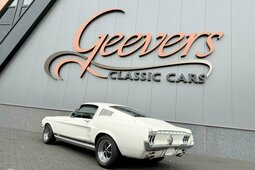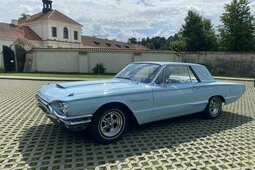American cars often get criticized for their crudeness, lackluster technology or not being sophisticated enough to fit European standards, creating an aura that outside of the US, these cars have no place among complex German engineering. Lacking in technology is a thing of the past however, with Lucid, Rivian and even Cadillac being some of the most technologically advanced and exciting cars you can buy today. But in terms of design, American manufacturers have always had something up their sleeves, successfully creating some of the most beautiful and trend setting designs in various periods.
One of them being the Cord 810, a forward looking luxury car, unveiled in 1936. The 810 can be described as being somewhat of a Citroen Traction Avant of America. It was an icon of interwar automotive design and innovation. The Gordon Buehrig designed transatlantic style body featured hidden headlights and a prominent coffin nose grille, setting it apart from its contemporaries. The 810 and later 812 was also revolutionary mechanically, boasting front-wheel drive and an independent front suspension, technologies rarely seen in the period. This design influenced a good bit of future automotive engineering and aesthetics, paving the way for streamlined, technology oriented vehicles. Though production was short-lived, the Cord 810’s and 812's legacy endures.
Light blue was not the most popular color for the Mark II, but it certainly compliments it well.
The Continental Mark II on the other hand was a car that defined the style of the 1950s. The Mark II, introduced in 1956, featured a clean, sophisticated design, with an achingly elegant silhouette, understated chrome accents, long hood and a short rear deck, embodying the pinnacle of 1950s American luxury. These were hand-built cars and their exclusive nature was often compared to European luxury cars. It was also no slouch, as it had one of the largest engines of the period, a 368 cubic inch 4bbl V8 with nearly 300 horsepower.
What is so significant about Pontiac in 1965? Well, ask Motor Trend, as they crowned the whole lineup (Tempest, GTO, LeMans, Star Chief, Catalina, Grand Prix, and Bonneville) as the best cars of the year, and they were not wrong. The 1965 Pontiac lineup was a pivotal moment for the Pontiac Motor Division, as it seemed that every little thing was made right with these cars. From durable, powerful V8 engines to excellent interior materials and styling, these cars took the attention of the American people. Their exterior showcased sleek, aggressive styling with sharp, clean lines, stacked headlights, and wide, imposing grilles that set a new standard for family and muscle car aesthetics. Their styling worked so well, that other manufacturers, such as Ford, even copied the stacked headlight theme with their cars in 1966 and later model years.
The 1972 Imperial LeBaron was a standout. It was part of the 1968–1973 generation of Chrysler full-size cars, known today as Fuselage Chryslers. But the top dog, the Imperial LeBaron was the best of them all. Its bold, imposing presence featured an airplane like body, hidden headlights, and a commanding front grille, giving it a distinctive and prestigious appearance, almost menacing and downright frightening, as it was one of the largest cars on sale in the late 60s and early 70s. The Imperial also had a Torsion-Aire suspension system, which utilized longitudinal torsion bars instead of traditional coil springs. This setup provided an exceptionally smooth and controlled ride. Power was generated by a massive 440 cubic inch V8 engine.
1984 marked the beginning for the C4 Chevrolet Corvette as a significant leap in sports car design and technology. The C4 was one of the most seamless looking cars of the 1980s, being completely reworked with slender, computer designed suspension, modern interior and brand new engines. With its sleek, aerodynamic shape, the C4 boasted a low drag coefficient of 0.34. The design featured a clamshell hood and advanced materials like aluminum and composite panels, reducing weight while enhancing rigidity. While the C3 was getting long in the tooth, the C4 brought everything back to life. It solidified the Corvette's reputation as a leading American performance icon.
The current shape Dodge Challenger was reintroduced in 2008. Its design pays homage to the classic 1970s model with its bold, retro styling, including a wide stance, and signature split taillights. The under-hood performance of these cars is well know by now, but people these days tend to take the Challenger for granted, since it has been in production for nearly 17 years and forgetting how great its styling is. The Challenger was a huge part of the reinvigorated muscle car segment, blending vintage aesthetics with contemporary engineering, along with the Ford Mustang and Chevrolet Camaro of the period.
Design of the last generation Ford GT started with its aerodynamics, aligning with Ford's ultimate goal of creating a successful Le Mans race car. Prioritizing low drag and aerodynamic efficiency, they aimed for a 'teardrop profile' similar to those seen in LMP1 cars. Consequently, the powertrain was a secondary consideration to the car's exterior, therefore a relatively uninspiring EcoBoost V6 was chosen for its flexibility. The overall look of the second-gen GT was intended to be clearly recognizable as part of the GT lineage, featuring elements like a cut-back front nose, circular tail lights, and raised twin exhaust pipes. There’s a certain lightness and dynamic aura to it that even some supercars fail to achieve.
---
Want to own a piece of American design history? Delve into our Car Categories. Or, delve into our Classic Passion Shop for an exciting array of products from our partners, perfect for enthusiasts looking to enhance their collection!















